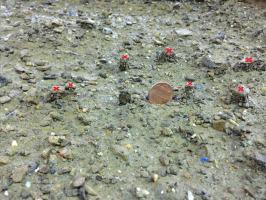Our official English website, www.x-mol.net, welcomes your
feedback! (Note: you will need to create a separate account there.)
Characterizing detachment and transport processes of interrill soil erosion
Geoderma ( IF 5.6 ) Pub Date : 2020-10-01 , DOI: 10.1016/j.geoderma.2020.114549 X.C. (John) Zhang , F.L. Zheng , J. Chen , J.D. Garbrecht
Geoderma ( IF 5.6 ) Pub Date : 2020-10-01 , DOI: 10.1016/j.geoderma.2020.114549 X.C. (John) Zhang , F.L. Zheng , J. Chen , J.D. Garbrecht

|
Abstract Detachment and transport processes of interrill soil erosion are not yet fully understood and quantified due to their complexity. Understanding these processes and their interaction is essential to developing effective interrill erosion prediction models. Thus, the objectives are to (1) identify detachment-limiting and transport-limiting regimes by comparing measured total soil splash with total sediment load of flow wash, (2) estimate relative importance of raindrop-driven and flow-driven transports under selected flow conditions using a novel experimental protocol, and (3) test widely used erosion equations for use in both detachment-limiting and transport-limiting regimes under the experimental conditions never before used. Sediment discharge and raindrop splash were separately collected from two plots with a 2.5-cm gap between them. Three rainfall intensities of 60, 90, and 120 mm h−1 were applied to three slopes of 9, 18, and 27% under two cover treatments of screen and tarp. Screen cover is to simulate crop canopy for dissipating raindrop energy, which is to control upslope sediment inflow by reducing raindrop detachment without modifying runoff rates. Tarp cover is to control both water and sediment inflows by varying slope length. Results showed that total raindrop splash in the entire plot during an event was less than total flow wash in the screen treatment, indicating detachment-limiting scenarios. However, total raindrop splash was greater (less) than total wash at the 9% (27%) slope in the tarp treatment, indicating transport-limiting (detachment-limiting) cases. The results indicated that raindrop-impacted flow might be able to detach soil in some cases. This finding runs counter to the common wisdom that soil detachment in interrill erosion is solely caused by raindrop impact. If raindrop-impacted flow can detach soil, the determination of limiting process by direct comparison between splash and wash loads seemed overly simplistic. Raindrop-driven transport was estimated for the first time by a means of dissipating raindrop impact energy in this study. Raindrop-driven transport was found to increase with rainfall intensity and slope gradients. Stream power and an empirical multiplication-of–factor equation performed well in predicting interrill sediment delivery under all erosion regimes, suggesting that it is unnecessary to develop distinct predictive equations for different interrill erosion regimes.
中文翻译:

表征Interrill土壤侵蚀的分离和运输过程
摘要 由于土壤侵蚀的复杂性,尚未完全了解和量化Interrill 土壤侵蚀的分离和迁移过程。了解这些过程及其相互作用对于开发有效的流间侵蚀预测模型至关重要。因此,目标是 (1) 通过比较测量的总土壤飞溅与水流冲刷的总沉积物负荷来确定分离限制和传输限制机制,(2) 估计在选定流量下雨滴驱动和水流驱动传输的相对重要性条件使用新的实验协议,和 (3) 测试广泛使用的侵蚀方程,用于在以前从未使用过的实验条件下的分离限制和运输限制制度。从两个地块之间分别收集沉积物排放和雨滴飞溅,它们之间的间隙为 2.5 厘米。分别对 9%、18% 和 27% 的三个坡度施加 60、90 和 120 mm h−1 的三种降雨强度,并在两种覆盖处理下进行筛网和篷布处理。筛网覆盖模拟作物冠层消散雨滴能量,即通过减少雨滴脱离而不改变径流速率来控制上坡沉积物流入。防水布盖是通过改变斜坡长度来控制水和沉积物的流入。结果表明,事件期间整个小区的总雨滴飞溅小于筛网处理中的总水流冲刷,表明存在脱离限制的情况。然而,在防水布处理中,在 9% (27%) 坡度处,总雨滴飞溅大于(小于)总冲刷,表明运输限制(分离限制)情况。结果表明,在某些情况下,受雨滴影响的水流可能能够使土壤分离。这一发现与普遍的看法背道而驰,即在地层侵蚀中土壤脱离完全是由雨滴撞击引起的。如果雨滴影响的水流可以分离土壤,那么通过直接比较飞溅和冲洗载荷来确定限制过程似乎过于简单。在这项研究中,首次通过消散雨滴冲击能量的方式估计了雨滴驱动的运输。发现雨滴驱动的运输随着降雨强度和坡度梯度而增加。溪流功率和经验乘法因子方程在预测所有侵蚀状况下的溪间沉积物输送方面表现良好,这表明没有必要为不同的溪间侵蚀状况开发不同的预测方程。
更新日期:2020-10-01
中文翻译:

表征Interrill土壤侵蚀的分离和运输过程
摘要 由于土壤侵蚀的复杂性,尚未完全了解和量化Interrill 土壤侵蚀的分离和迁移过程。了解这些过程及其相互作用对于开发有效的流间侵蚀预测模型至关重要。因此,目标是 (1) 通过比较测量的总土壤飞溅与水流冲刷的总沉积物负荷来确定分离限制和传输限制机制,(2) 估计在选定流量下雨滴驱动和水流驱动传输的相对重要性条件使用新的实验协议,和 (3) 测试广泛使用的侵蚀方程,用于在以前从未使用过的实验条件下的分离限制和运输限制制度。从两个地块之间分别收集沉积物排放和雨滴飞溅,它们之间的间隙为 2.5 厘米。分别对 9%、18% 和 27% 的三个坡度施加 60、90 和 120 mm h−1 的三种降雨强度,并在两种覆盖处理下进行筛网和篷布处理。筛网覆盖模拟作物冠层消散雨滴能量,即通过减少雨滴脱离而不改变径流速率来控制上坡沉积物流入。防水布盖是通过改变斜坡长度来控制水和沉积物的流入。结果表明,事件期间整个小区的总雨滴飞溅小于筛网处理中的总水流冲刷,表明存在脱离限制的情况。然而,在防水布处理中,在 9% (27%) 坡度处,总雨滴飞溅大于(小于)总冲刷,表明运输限制(分离限制)情况。结果表明,在某些情况下,受雨滴影响的水流可能能够使土壤分离。这一发现与普遍的看法背道而驰,即在地层侵蚀中土壤脱离完全是由雨滴撞击引起的。如果雨滴影响的水流可以分离土壤,那么通过直接比较飞溅和冲洗载荷来确定限制过程似乎过于简单。在这项研究中,首次通过消散雨滴冲击能量的方式估计了雨滴驱动的运输。发现雨滴驱动的运输随着降雨强度和坡度梯度而增加。溪流功率和经验乘法因子方程在预测所有侵蚀状况下的溪间沉积物输送方面表现良好,这表明没有必要为不同的溪间侵蚀状况开发不同的预测方程。











































 京公网安备 11010802027423号
京公网安备 11010802027423号